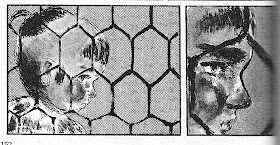
Yesterday I referred to the premise of Lone Wolf and Cub as "outrageous," since it saddles a disgraced samurai assassin, Itto Ogami, with a little child, his son Daigoro, as Ogami creates heaps of corpses in pursuit of a quest that is still only partly explained by the end of the second 300-page volume.
But of course, the Lone Wolf isn't really alone; and some of the more dramatic shifts in tone and focus depend on the little tyke who makes this series so outrageous: Daigoro.
 At times, I confess, I would rather do without him. His presence can tilt an episode, if only momentarily, into excessive sentimentality...
At times, I confess, I would rather do without him. His presence can tilt an episode, if only momentarily, into excessive sentimentality... 
...or even greater implausibility:
 Yet, for all the threat of moments maudlin or laughable, the episode from which the previous three panels derive works well to show the questionable influence of Ogami's choices on Daigoro's life—and to reveal just how dangerous it is for anyone to draw near them, even out of would-be pity or friendship. (Even when Ogami doesn't always know what's going on, he's fearsomely deadly.)
Yet, for all the threat of moments maudlin or laughable, the episode from which the previous three panels derive works well to show the questionable influence of Ogami's choices on Daigoro's life—and to reveal just how dangerous it is for anyone to draw near them, even out of would-be pity or friendship. (Even when Ogami doesn't always know what's going on, he's fearsomely deadly.)On the whole, Daigoro's leavening presence succeeds in maintaining an extra measure of sympathy for Ogami (who does display a fatherly tenderness to Daigoro on occasion, and whose quest is partly to avenge the murder of his wife, Daigoro's mother). At the same time, Daigoro's youth and vulnerability help to demonstrate more fully Ogami's implacable commitment to his cause and what it costs—costs Ogami knows all too well, but which Daigoro does not always understand:

*In Japanese, his name would be given surname first—Ogami Itto—but, like the artwork, his name is flipped for this Western survey.
No comments:
Post a Comment